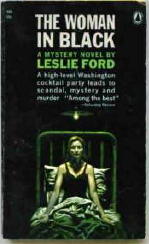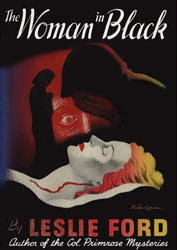Sun 10 Jun 2007
LESLIE FORD – The Woman in Black
Popular Library K63; reprint paperback, December1963. Hardcover: Charles Scribner’s Sons, May 1947. British hardcover: Collins (Crime Club), 1948. US hardcover reprint: Detective Book Club, 1948 [3-in-1 edition]. Other US paperback editions: Dell #447, mapback, 1950; Popular Library 60-2443, circa 1969. Magazine appearance: The Saturday Evening Post, a seven-part weekly serial from January 18 through March 1, 1947.

As far as I can recall, this is the first mystery by Leslie Ford that I can recall reading. In doing so, it was with a small amount of bias, shall we say, when I started, having been given negative impressions about her work from others who have read her recently. This negativity was said to lie in Ms. Ford’s attitudes toward racial minorities, but perhaps by 1947, when The Woman in Black was published, this lack of sensitivity had begun to disappear from her work.
Mrs. Grace Latham’s housekeeper Lilac is apparently black, but it is not so stated. The only way you will realize it is from her speech patterns. Here’s a sample, taken from page 19, the first time we meet her in the story. She’s helping to hide a young married woman who has come to Mrs. Latham for some advice:
By itself I think this is not only fairly innocuous but a pretty good example of a way with words. What the reader gets in these two lines, with no further description, a pretty good picture in his or her mind of who Lilac is and what she may even look like. Is it harmful? Is it demeaning? I’m predisposed to say no, but if you were to press me, I don’t think that it would be too difficult to convince me that any negative stereotyping, wherever or however it occurs, is ever entirely wholesome.
In any case, however, any racial attitudes that are displayed in the author’s earlier books, even done unconsciously, do not manifest themselves in this one to any degree more visibly than this. Not that I’m saying that the case is closed, but I also think that the backgrounds and settings of mystery novels, taken as a snapshot in time, do more to illustrate the attitudes and opinions of everyday people — for better or worse — than any number of history textbooks I ever studied from when I was in school.
Grace Latham, who appeared in many of Ms. Ford’s books, is a widow and apparently a Washington socialite of some stature and renown. She has also made her mark as a sleuth of some distinction, even if only peripherally, as in this one, since the bulk of the real detective work is done by Colonel Primrose’s stalwart assistant, Sergeant Buck, and Captain Lamb of the Washington police department, who also appeared in many of Mrs. Latham’s adventures, but not all.

After retiring from the military, John Primrose and Phineas T. Buck operated in tandem what Grace calls on page 13 a “subterranean private investigation business,” their clients very often being various governmental agencies. Primrose himself does not make an official appearance in this book. He’s quarantined with the measles throughout its duration. Behind the scene, however, he’s actively behind the investigation into the murder that occurs in this case, making numerous suggestions and keeping Grace out of trouble, or trying to.
Dead is a woman who may have been blackmailing a wealthy industrialist who may have his eye on the White House, the blackmailer therefore being in two ways the lady in the title of the book. One of the various people surrounding the would-be presidential candidate, all of whom were at the same cocktail party, is very likely to have been the killer. Most of them are known to Grace, if not close friends, which many of them are, which makes solving the murder all the more difficult for her.
Leslie Ford’s prose is sometimes not easy to read, and sometimes the time and location of where her characters are at any one time seem to be taken too much for granted. The difficulty in reading is also due to a “fretful” way of talking that sometimes seems to bunch itself up too much, making it slow going at times to work one’s way through.

I think the following paragraph, the one quoted at some length below, may go a long way in illustrating this. Grace is with Sergeant Buck, who is trying to reassure her that Susan Kent (the woman being comforted in the quote up above) is not the killer. Grace, by the way, tells the story herself — all but a short Chapter One, which acts like a prologue, which I generally dislike, and once again, yes, I generally dislike it here as well. But to return to page 96, which I was leading up to, before that last digression:
Don’t get me wrong, though. Leslie Ford seems to have had an excellent insight into people, why they react the way they do; and into marriages that work, and those that don’t. The mystery element — the whodunit part — is also done in a highly acceptable fashion, all wrapped up in a package that in the end is worth unwrapping. To be completely honest, though, for those willing to stop reading a book that seems unsatisfactory before finishing it, there may easily be doubts along the way.
May 11th, 2008 at 10:40 pm
[…] review of Ford’s The Woman in Black appeared here on the M*F blog a while back, in case you’d like to go back and take a […]
May 25th, 2020 at 1:27 pm
[…] Woman in Black has been reviewed, among others, at Golden Age of Detention Wiki, Mystery File, and Pretty Sinister […]